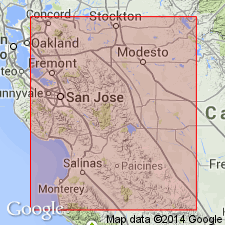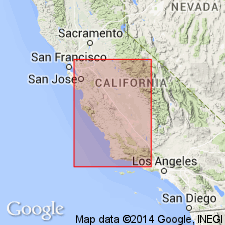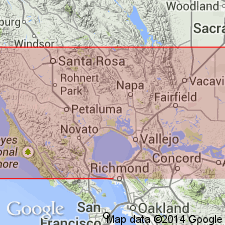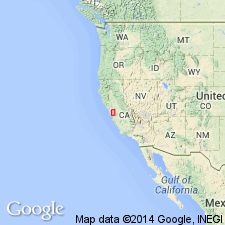
- Usage in publication:
-
- Cierbo group
- Modifications:
-
- Original reference
- Dominant lithology:
-
- Conglomerate
- Sandstone
- AAPG geologic province:
-
- Sacramento basin
Summary:
Pg. 596-614. Cierbo group. The use of San Pablo for upper Miocene series of deposits on West Coast makes it necessary to dispense with the use of that name for a part of the group. The name Cierbo is therefore used in this paper in referring to middle group of San Pablo series. These marine beds are recognized only in general region of San Francisco Bay, where they lie disconformably below Santa Margarita group and rest disconformably on Briones group.
Type section: south side of Canada del Cierbo near Carquinez Straits, [Benicia 7.5-min quadrangle, Contra Costa Co.], Mount Diablo region, western CA.
Source: US geologic names lexicon (USGS Bull. 896, p. 444); GNU records (USGS DDS-6; Menlo GNULEX).

- Usage in publication:
-
- Cierbo formation
- Modifications:
-
- Revised
- Adopted
- AAPG geologic province:
-
- Sacramento basin
Summary:
Pg. 751-770. Cierbo formation of San Pablo group. (SCUTELLA GABBI zone.) Included Cierbo in San Pablo group, as explained under San Pablo group. [See also Clark and Woodford (1927) entry under San Pablo group.] Age is late Miocene. This is present [ca. 1936] accepted definition of the USGS.
Source: US geologic names lexicon (USGS Bull. 896, p. 444).

- Usage in publication:
-
- Cierbo sandstone
- Modifications:
-
- Mapped
- Biostratigraphic dating
- AAPG geologic province:
-
- Sacramento basin
Summary:
Pg. 17 (table 3), 78-80, pls. 11-13 (geol. maps). Cierbo sandstone of San Pablo group. Exposed in San Pablo area, Contra Costa County, southern parts of Carquinez and Mare Island quadrangles. Is approximately 900 feet thick; upper 160 feet is yellowish- and brownish-gray concretionary medium-grained sandstone with lesser amounts of gray tuffaceous shale; lower part composed of alternating layers of fine- and coarse-grained brownish-gray sandstone. Rests with erosional unconformity on Briones sandstone of San Pablo group. Underlies Neroly sandstone of San Pablo group; top of Cierbo placed at contact between concretionary sandstones and overlying cross-bedded pebbly and conglomeratic sandstone of the Neroly. Also well exposed in Los Medanos hills (local name), north of Mount Diablo, Contra Costa County, southwestern corner Antioch quadrangle; beds may continue beneath Suisun Bay. In Los Medanos hills unconformably overlies Eocene Markley sandstone. Fossils indicate ECHINARACHNIUS GABBI zone [listed]. Age is late Miocene.
Source: Publication; US geologic names lexicon (USGS Bull. 1200, p. 802-803); GNU records (USGS DDS-6; Menlo GNULEX).

- Usage in publication:
-
- Cierbo Sandstone*
- Modifications:
-
- Revised
- Redescribed
- AAPG geologic province:
-
- Sacramento basin
Summary:
Cierbo formation of Clark (1930) is redescribed as Cierbo Sandstone, middle formation of San Pablo Group. Age given as late Miocene.
Source: GNU records (USGS DDS-6; Menlo GNULEX).
For more information, please contact Nancy Stamm, Geologic Names Committee Secretary.
Asterisk (*) indicates published by U.S. Geological Survey authors.
"No current usage" (†) implies that a name has been abandoned or has fallen into disuse. Former usage and, if known, replacement name given in parentheses ( ).
Slash (/) indicates name conflicts with nomenclatural guidelines (CSN, 1933; ACSN, 1961, 1970; NACSN, 1983, 2005, 2021). May be explained within brackets ([ ]).

